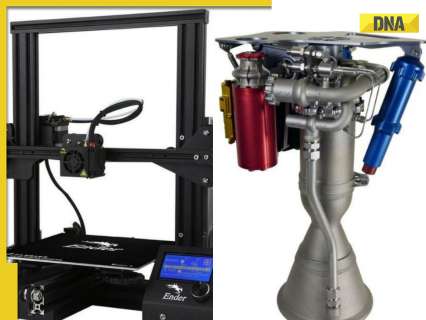
The 3D-printing method typically reduces both construction and labor costs by 50% compared to traditional buildings of the same size.
India’s First 3D-Printed Post Office in Bengaluru
In August 2023, India’s first 3D-printed post office was unveiled in Cambridge Layout, Bengaluru. The construction, managed by Larsen & Toubro (L&T) with technical support from IIT Madras, took just 43 days. Covering an area of 1,021 square feet, the building was created using 3D concrete printing technology, which involves a robotic printer layering concrete according to a pre-designed plan. The use of special quick-hardening concrete ensured the structure bonded well during printing.
L&T explained that robotic assistance helped cut down the construction time from the usual 6-8 months to just over a month. The total cost of the project was Rs 23 lakh, saving 30-40% compared to traditional methods. The concrete material used was specifically chosen for its ease of use, strength, and durability.
The 3D-printing method typically reduces both construction and labor costs by 50% compared to traditional buildings of the same size. This leads to improved efficiency, better economic gains, and greater sustainability.
Major defense companies, particularly drone makers and aerospace firms involved in rocket and satellite parts, have rapidly embraced 3D printing for military and civilian use. Although the technology has been around for years, advancements have turned it from a concept into a practical tool in various industries across India.
Military applications of 3D printing
In the defense industry, 3D printing is often called additive manufacturing. It works by building an object layer by layer from a digital design, using a specific material to form the exact shape needed.
Each layer can be highly detailed, allowing 3D printers to make parts that move, like hinges and wheels, all within the same object. Restrictions on materials, which used to be a limitation, are also becoming less of an issue.
This has led many industries to adopt 3D printing in their daily operations. For example, the automotive industry uses it to create hybrid cars, and the healthcare sector uses it to replace damaged bones and tissues in the human body.
Indian space startup Agnikul Cosmos successfully launched the nation’s first 3D-printed rocket engine on Thursday (May 30 2024), paving the way for reduced time and costs associated with building rockets and boosting the country’s spacefaring capabilities.
Less than ten years ago, 3D printers could only create basic objects, so it’s exciting to think about what additive manufacturing could bring to the future of the defense industry.
Traditional manufacturing methods like CNC (computer numerical control) machining involve a highly precise process controlled by computers. Unlike 3D printing, CNC machining is a subtractive process, where solid blocks of material are cut and shaped into the desired product by removing excess material.
As the name suggests, subtractive manufacturing starts with a solid block of material, which is then trimmed and shaped by cutting away the excess until the final design is created.
With 3D printing, you begin with nothing and gradually build the object using only the material needed, leading to significant cost savings.
In the near future, 3D printing will become a regular part of traditional manufacturing and a key feature of most assembly lines. Faster and stronger 3D printers, capable of producing consistent, high-quality results, will enable large-scale production to match traditional methods. This shift has already started.
Many machine manufacturers have begun offering hybrid CNC machines that combine traditional material removal techniques with 3D printing, providing precise and efficient manufacturing solutions.
Quicker and more durable 3D printers, capable of producing consistent, high-quality results, will drive large-scale manufacturing to match traditional methods. The benefits of 3D printing compared to other manufacturing methods are significant, bringing major changes to how products are designed and created.
For equipment manufacturers, 3D printing provides a cost-effective way to create prototypes of complex parts to ensure they fit the design before using CNC machining. This method allows companies to quickly test different designs without needing special tools, helping them gauge customer preferences, lower product risk, and speed up the time to market.
The initial prototype is usually not the final version of a product. Most products go through multiple rounds of testing and review before the design is finalized. With these limitations in mind, 3D printing is the best way to accelerate this process. With traditional prototyping, the process of testing, adjusting, and improving a design could take weeks or even months. Now, with 3D printing, it can be done in just a few days.
3D printing is central to today’s on-demand, highly personalized economy, transforming how we handle design, inventory, and logistics.In a combat zone, where spare parts aren’t available, replacement parts can be made on-site almost instantly. This allows manufacturers to deliver weapons systems more quickly while also improving their designs.
Fleets of drones or unmanned aerial vehicles can increase their range and carrying capacity as outdated parts are redesigned, 3D printed, and sent back into action in just days or even hours. Looking ahead, 3D printers will offer even more flexibility. They will be able to print objects made from different materials, like metal, ceramics, concrete, and plastics, all on the same machine, opening up many more possibilities for use.
Several companies are now using 3D printing as their main production method. It’s difficult to predict the full impact 3D printing will have in the future. Simply put, this technology has the power to transform how we create products. Additive manufacturing has the potential to revolutionize not just the defense industry, but many others as well.
(The author of this article is a Defence, Aerospace & Political Analyst based in Bengaluru. He is also Director of ADD Engineering Components, India, Pvt. Ltd, a subsidiary of ADD Engineering GmbH, Germany. You can reach him at: girishlinganna@gmail.com)
(Disclaimer: The views expressed above are the author’s own and do not reflect those of DNA)
